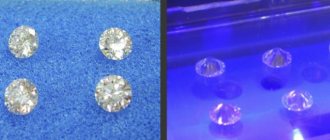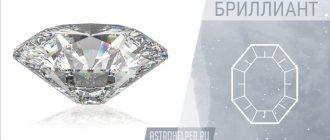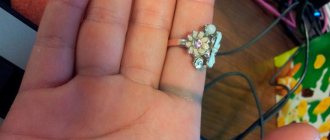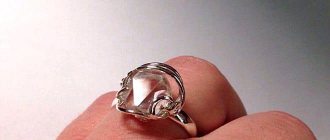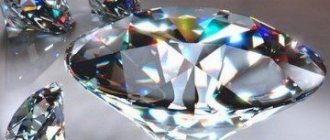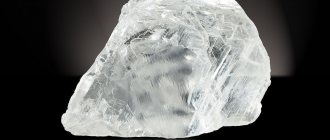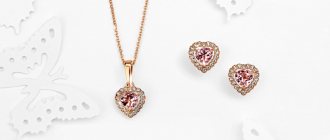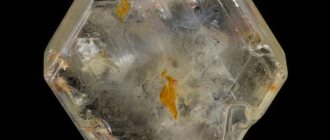Everything in this world is not eternal. Almost everything turns to dust over time. And unfortunately no one can change this. Still, there are things in our world that, according to many, are unchangeable. Today I want to talk about one such object - a diamond. Diamond is rightfully considered one of the hardest minerals in the world. But still…
Did you know that diamonds can burn? This interesting phenomenon was discovered as a result of experiments that were carried out with this mineral. As a result of experiments, it turned out that at high temperatures (850-1000 degrees C), a very hard mineral changes its structure and turns into pure carbon dioxide, leaving no other substances. This was proven for the first time in 1694, when scientists from Italy K.A. Tardgioni and G. Averani tried to combine several small diamonds into one large diamond. The combustion temperature at which a diamond burns
in a stream of pure oxygen it is a little less: 720-800 degrees C. Moreover, the mineral burns with a beautiful blue flame.
Again, interesting, in my opinion, is the fact that it is possible to produce ordinary graphite from diamond. To do this, you just need to heat the stone, in the absence of oxygen, to a temperature of 2000 degrees C.
All of the above facts have been proven many times by scientists in practice, and subsequently scientifically substantiated.
So women remember that diamond burns
, a diamond on your finger can turn into ordinary graphite from high temperature. Remember this and be careful not to get excited.
Burning diamonds. Video.
Interesting pages of our website:
Bad weather. Interesting facts about rain
Underground boat. Secret developments
Bogomolov accelerator. Is it possible to completely destroy a single country?
Diamond is a rather rare and expensive stone. It is born deep in the earth and comes to the surface in the form of a kimberlite pipe. This mineral was discovered a long time ago, but only in the sixteenth century did scientists begin to study the properties of this precious stone. After numerous experiments, physicists gave an answer about the structure and properties of diamond.
But the study of this mineral is still ongoing. Currently, there is no exact answer to the question - what will happen if you melt a diamond? The discovery of the structure and properties of the mineral made it possible to use it not only as jewelry, but also in various industries.
Diamond structure and properties
The structure of diamond is a crystal lattice of carbon atoms with a very strong bond, which determines its properties.
- Diamond hardness. It is the hardest of all minerals currently known. Due to its structure, it is impossible to destroy or damage its surface with other minerals or objects.
- Absence of diamond reaction to aggressive chemical environments in the form of alkalis and acids.
- Mineral fragility.
The peculiarity of the structure of the crystal lattice of the mineral makes it fragile. When a stone is hit hard, it breaks into small pieces. This property is used by jewelers when cutting diamonds.
If the basic properties of diamond have been studied to a greater extent, what properties will the mineral have if you try to melt it? Experimental experiments on the topic: “how to melt a diamond” have been carried out and are currently being carried out by physicists.
How to melt a diamond
Physicists managed, as a result of the experiment, to obtain liquid drops of diamond, but they failed to measure the melting point and record the new properties of the mineral in this state. When a diamond is heated in the usual way in air to a temperature of 1000 degrees Celsius, it burns, and in a vacuum, at a temperature of 2000 degrees, it turns into graphite.
Scientists, during the experiment, decided to expose a natural diamond of one tenth of a carat to high temperature, 3500 degrees Celsius and high pressure shock wave (pressure reached 11 million atmospheres) using laser pulses.
With a gradual decrease in temperature and pressure, formations appeared in the form of pieces of ice that did not sink on the surface of the resulting liquid. The number of these solid formations at a constant temperature and reduced pressure increased more and more.
Due to the complexity of the experimental conditions, it was not possible to study the properties of the molten form of diamond. However, similar manifestations have been recorded on Neptune and Uranus. There is a possibility that in the depths of these planets there are seas of molten diamonds.
Second life in advertising
Both metals turned out to be extremely resistant to corrosion, even surpassing gold and platinum in this indicator. And given their hardness, they seemed very promising for use for practical purposes. But in the 19th century, the only generally useful thing that could be made from them was a small indelible ball of iridium on the tip of a gold or platinum fountain pen, which was dipped in ink. Such a pen cost a gold guinea, that is, about one and a half pounds sterling at the exchange rate of the 1830s, when such pens appeared on sale.
In the 20th century, such a ball made of iridium alloys was supplied with the nibs of expensive fountain pens, including the famous Parker 51, which was probably used to sign most international treaties from the 1930s to the 1980s and which, as you know, was used by James Bond. True, the Parker ball at the end of the pen consisted of an alloy of iridium with ruthenium, in which iridium was only 3.8%. So for snobs, if they knew the history of chemistry, in terms of prestige, or “coolness”, as they say now, the most sophisticated modern “Parker” versus a fountain pen from the last century for a guinea is the same as a Japanese serial Seiko watch versus a Patek Philippe chronograph.
In 1933, a thermocouple was made from an alloy of iridium and ruthenium to measure high temperatures up to 2000 degrees Celsius. In 1957, Rudolf Mössbauer discovered the resonant absorption of gamma radiation by iridium nuclei (the Mössbauer effect, one of the “epoch-making discoveries in 20th-century physics,” as it is called). Now the area of practical use of iridium and osmium is much wider, but all their applications are associated with an increased melting point, hardness and corrosion resistance. For example, in 2006, American Elements developed a technology for casting seamless iridium rings for use in spacecraft and satellites.
In 2016, American Elements established a subsidiary of Smithson Tennant, which began producing iridium jewelry using the same technology, most notably Smithson Tennant iridium wedding rings. When promoting them to the market, the company emphasizes that they are eternal in the literal sense of the word: they can be dipped in concentrated acid and nothing will happen to them. Quite a strange advertisement... I don’t want to think what will happen to the ring finger of the bride or groom if they stick it in acid, but really nothing will happen to the ring, it won’t even tarnish. As for the trademark of these rings, Tennant, a member of the Royal Society of London, could hardly have expected that two centuries after his death he would become the advertising face of newfangled premium iridium jewelry.
Will lava melt a diamond?
The temperature of the lava ranges from 500 to 1200 degrees. The melting point of diamond starts at 3500 degrees (this requires a pressure of more than 11 GPa). So no, lava cannot melt a diamond. However, she is able to burn him, because... At atmospheric pressure, a diamond burns at a temperature of 1000 degrees.
Interesting fact
. In 2013, diamond placers were discovered in the lava of active volcanoes in Kamchatka. How is this possible if they are supposed to burn. After a series of studies, scientists concluded that these were newly formed diamonds with new properties. They were even given a separate name - Tolbachinsky. As the report states: “diamonds were formed in volcanic gases as a result of shock crystallization under the influence of lightning electrical discharges.”
Scientists are still arguing about what substance diamond turns into during melting. Since the 16th century, when the mineral was discovered, it has been actively studied. But many mysteries have not yet been solved. Over more than 500 years, many experiments have been conducted in scientists' quest to solve this mystery. But most of the properties of the stone still remain unexplored. Each discovery takes many years. In our article, we will open for you one of the curtains, behind which a lot of interesting things are hidden.
Where are diamonds found in the earth's crust?
These minerals are extremely rare. However, industrial deposits today are being developed on almost all continents of the globe. The only exception is Antarctica.
Until the mid-19th century, it was believed that minerals formed in river sediments. Later, the first diamond-bearing cavities were discovered in rocky mountain soil at a depth of several hundred meters.
According to scientists, the age of some diamonds ranges from 100 million to 2.5 billion years. Researchers managed to obtain “older” minerals of unearthly origin. The latter were brought to the planet along with meteorites that formed in outer space even before the formation of the Solar System.
About basic properties
The possibility of its use in both the jewelry industry and industry depends on the temperature at which diamond melts. But the characteristics have not yet been fully studied, since the stone has unique properties. It is difficult to compare it with anything known to the world.
One explanation for such unusual characteristics of the mineral is its extraterrestrial origin. There is a theory that the diamond came to the planet from space along with meteorites and settled in the bowels of the earth. Other scientists explain the strange behavior of the stone by the structure of its crystal lattice.
The carbon atoms in it have a super-strong bond, which determines the already known properties of diamond:
- abnormal hardness;
- resistance to aggressive chemical environments (alkali and acid);
- fragility.
The paradox of diamond is that, on the one hand, it is the most durable mineral on the planet. But on the other hand, it is very fragile and can be easily damaged by a strong blow. Jewelers use the latter property when cutting.
Double opening
Tennant's second discovery, which had long-term consequences in the jewelry business, concerned the two hardest and very rare metals, the content of which in the earth's crust is 10 times less than platinum and 40 times less than gold. Tennant discovered them both at once, as they say, in one sitting, dissolving platinum, or more precisely, platinum ore from Colombia, in aqua regia (a mixture of concentrated nitric and hydrochloric acids).
The platinum dissolved, leaving only a black impurity residue in the ore. Tennant fused this insoluble residue with alkali and first tried to dissolve the resulting substance in water. The water turned yellow and another black solid precipitated. The yellow solution was osmium tetroxide solution. All that remained was to evaporate it and obtain the salt of some as yet unknown metal, then calcinate it and obtain this metal in its pure form. Tennant called it osmium (translated from ancient Greek as “odorous”; its salt smelled strongly, or rather, even stank like rotten radishes).
Photo: Getty Images
Photo: Getty Images
Then, after removing the osmium from it, Tennant tried to dissolve the black precipitate in hydrochloric acid, and he fused what was left after that with caustic soda and again tried to dissolve it in acid. This time the solution turned red, and small red crystals fell out of it. It was the salt of some other metal. Tennant calcined it and obtained a white metal powder. He named the new metal iridium (in ancient Greek - “rainbow”), probably because of the different colors of its salts.
Interesting properties studied during experiments
Diamond is the most amazing stone. Its nature and properties force the smartest people on the planet to solve the most difficult problems. His beauty delights millions. It is one of the best dielectrics and insulators. It contains only carbon atoms.
It is curious that carbon itself is an extremely flammable substance. In nature, it is most often found in the form of graphite. This gave scientists the idea of converting one substance into another. They were interested in whether, during the melting process, diamond would transform into graphite and vice versa. The results were mixed.
It turned out that it is possible to create graphite from diamond by heating the crystal to 2000 degrees and blocking the access of oxygen. But it was not possible to carry out the reverse reaction without making a seed. You can read about this in the article If a stone is not heated in a vacuum, it will simply turn into carbon.
Transition from one state to another
Based on the temperature and environment in the melting furnace, you can predict what state the diamond will go into. If oxygen is present in the flask, the stone will completely burn at a temperature of 850-1000 degrees Celsius. During the reaction, a pale blue flame will be released. At the end of the experiment, CO2 - oxygen and carbon - will remain in the capsule.
This was proven back in 1694 by Italian scientists Targioni and Averani. They tried to fuse two small diamonds into one, but only burned the stones.
Their experiment failed because it is incredibly difficult to achieve a smooth melting of diamonds: you need a capsule without oxygen, with the ability to regulate the pressure inside it.
What substance diamonds turn into when heated to 2000-3000 degrees depends on the environment. If you shut off the oxygen and create a temperature of 1800-2000 degrees, you can get graphite. By raising the heat level to 3700-4000 degrees under the same conditions, you can get molten carbon. But it is extremely difficult to achieve such power from laboratory instruments.
The course of the experiment and its results
To determine at what temperature diamond melts, a large experiment was conducted in 2010. The 1/10 carat stone was placed in a special capsule, where nanosecond wave pulses were created. A pressure of 10 million atmospheres and a temperature of 40,000 Kelvin (39,726.85 Celsius) were reached in the furnace, after which the crystal turned into a liquid state.
The experiment did not end there. Scientists continued to raise the temperature and pressure. When the heat reached 50,000 Kelvin (49,726.85 Celsius), the diamond began to harden. Moreover, he did it literally in pieces - solid crystals formed on the surface of the molten mass.
The structure resembled an iceberg. Curiously, the molten mass did not boil or change when the scientists continued to increase the temperature. But as the degrees decreased and the pressure remained the same, the crystals became larger and fused into one.
Diamond Melting Conditions
In 2010, in the course of experiments, physicists from the laboratory of the University of California, located in Berkeley, determined the level of temperature exposure on diamond, which leads to its melting. Scientists have found that it is impossible to convert the material into liquid form under normal conditions, regardless of the level of heating. This goal can be achieved only by exposing the diamond not only to temperature, but also to high pressure. It is necessary to increase the pressure so that the mineral does not turn into graphite. Thus, the transition of diamond into liquid form is an extremely difficult process.
Phenomena and scientific facts
Scientists were not only interested in diamond melting. During one of the experiments on converting stone into carbon dioxide, an interesting discovery occurred. When the crystal was exposed to powerful ultraviolet rays, a cavity formed in the mineral.
We managed to find out that ultraviolet radiation harms diamonds. But this should not be a concern for diamond jewelry owners. It will take tens of thousands of years before the sun's rays can harm your jewelry.
Scientists have not been able to solve many of the mysteries of the diamond. For example, in jewelry workshops, stone can be easily heated, processed and soldered. However, if there are cracks in the diamond, it will shatter into small fragments.
Lava and carbon crystals
Due to the fact that diamond deposits are located in kimberlite pipes, where volcanic rock comes to the surface, natural concerns arise. Can lava melt a diamond? The answer is clear - no.
The fact is that the melting point of diamond is over 3500 degrees. And the pressure required is no joke, more than 11 hPa. The heat of the lava is only 500-1200 degrees. By simple comparison we come to the conclusion that lava flows can only burn the mineral if they reach 1000 degrees.
The word "diamond" comes from the Greek language. It is translated into Russian as "". Indeed, to damage this stone, superhuman efforts must be made. It cuts and scratches all the minerals known to us, while itself remaining unharmed. Acid does not harm him. One day, out of curiosity, an experiment was carried out in a forge: a diamond was placed on an anvil and hit with a hammer. The iron one almost split in two, but the stone remained intact.
Diamond burns with a beautiful bluish color.
Of all solids, diamond has the highest thermal conductivity. It is resistant to friction, even against metal. This is the most elastic mineral with the lowest compression ratio. An interesting property of diamond is to luminesce even under the influence of artificial rays. It glows with all the colors of the rainbow and refracts color in an interesting way. This stone seems to be saturated with the color of the sun and then radiates it. As you know, a natural diamond is not beautiful, but it is the cutting that gives it true beauty. A gemstone made from a cut diamond is called a diamond.
Why did Antoine Lavoisier burn the diamond?Eighteenth century, France, Paris. Antoine Laurent Lavoisier, one of the future creators of chemical science, after many years of experiments with various substances in the quiet of his laboratory, is convinced again and again that he has made a genuine revolution in science. His essentially simple chemical experiments on the combustion of substances in hermetically sealed volumes completely refuted the generally accepted theory of phlogiston at that time. But strong, strictly quantitative evidence in favor of the new “oxygen” theory of combustion is not accepted in the scientific world. The visual and convenient phlogiston model has become very firmly ingrained in our heads.
What to do? Having spent two or three years in fruitless efforts to defend his idea, Lavoisier comes to the conclusion that his scientific environment has not yet matured to purely theoretical arguments and that he should take a completely different path. In 1772, the great chemist decided to undertake an unusual experiment for this purpose. He invites everyone to take part in the spectacle of burning... a weighty piece of diamond in a sealed cauldron. How can one resist curiosity? After all, we are not talking about anything, but about a diamond!
It is quite understandable that, following the sensational message, the scientist’s ardent opponents, who had previously not wanted to delve into his experiments with all sorts of sulfur, phosphorus and coal, poured into the laboratory along with ordinary people. The room was polished to a shine and shone no less than a precious stone sentenced to public burning. It must be said that Lavoisier’s laboratory at that time belonged to one of the best in the world and was fully consistent with an expensive experiment in which the owner’s ideological opponents were now simply eager to take part.
The diamond did not disappoint: it burned without a visible trace, according to the same laws that applied to other despicable substances. Nothing significantly new has happened from a scientific point of view. But the “oxygen” theory, the mechanism of formation of “bound air” (carbon dioxide) have finally reached the consciousness of even the most inveterate skeptics. They realized that the diamond had not disappeared without a trace, but that under the influence of fire and oxygen it had undergone qualitative changes and turned into something else. After all, at the end of the experiment, the flask weighed exactly as much as at the beginning. So, with the false disappearance of the diamond before everyone’s eyes, the word “phlogiston” disappeared forever from the scientific lexicon, denoting a hypothetical component of the substance that is supposedly lost during its combustion.
But a holy place is never empty. One went, another came. The phlogiston theory was supplanted by a new fundamental law of nature - the law of conservation of matter. Lavoisier was recognized by historians of science as the discoverer of this law. Diamond helped convince humanity of its existence. At the same time, these same historians have created such clouds of fog around the sensational event that it still seems quite difficult to understand the reliability of the facts. The priority of an important discovery has been disputed for many years now, without any reason, by “patriotic” circles in various countries: Russia, Italy, England...
What arguments support the claims? The most ridiculous ones. In Russia, for example, the law of conservation of matter is attributed to Mikhail Vasilyevich Lomonosov, who did not actually discover it. Moreover, as evidence, the scribblers of chemical science shamelessly use excerpts from his personal correspondence, where the scientist, sharing with colleagues his reasoning about the properties of matter, allegedly personally testifies in favor of this point of view.
Italian historiographers explain their claims to the priority of a world discovery in chemical science by the fact that... Lavoisier was not the first to have the idea to use diamond in experiments. It turns out that back in 1649, prominent European scientists became acquainted with letters reporting similar experiments. They were provided by the Florentine Academy of Sciences, and from their contents it followed that local alchemists had already exposed diamonds and rubies to strong fire, placing them in hermetically sealed vessels. At the same time, the diamonds disappeared, but the rubies were preserved in their original form, from which the conclusion was drawn about the diamond as “a truly magical stone, the nature of which defies explanation.” So what? We are all, in one way or another, following in the footsteps of our predecessors. And the fact that the alchemists of the Italian Middle Ages did not recognize the nature of diamond only suggests that many other things were inaccessible to their consciousness, including the question of where the mass of a substance goes when it is heated in a vessel that excludes access to air.
The authorial ambitions of the British also look very shaky, as they generally deny Lavoisier’s involvement in the sensational experiment. In their opinion, the great French aristocrat was unfairly credited with credit that actually belonged to their compatriot Smithson Tennant, who is known to mankind as the discoverer of the two most expensive metals in the world - osmium and iridium. It was he, as the British claim, who performed such demonstration stunts. In particular, he burned diamond in a golden vessel (previously graphite and charcoal). And it was he who came up with the important conclusion for the development of chemistry that all these substances are of the same nature and, upon combustion, form carbon dioxide in strict accordance with the weight of the substances being burned.
But no matter how hard some historians of science try, either in Russia or in England, to belittle Lavoisier’s outstanding achievements and assign him a secondary role in unique research, they still fail. The brilliant Frenchman continues to remain in the eyes of the world community as a man of a comprehensive and original mind. Suffice it to recall his famous experiment with distilled water, which once and for all shook the prevailing view among many scientists at that time about the ability of water to turn into a solid substance when heated.
This incorrect view was formed on the basis of the following observations. When the water was evaporated “to dryness,” a solid residue was invariably found at the bottom of the vessel, which for simplicity was called “earth.” This is where there was talk about turning water into land.
In 1770, Lavoisier put this conventional wisdom to the test. To begin with, he did everything to get the purest water possible. This could be achieved then only in one way - distillation. Taking the best rainwater in nature, the scientist distilled it eight times. Then he filled a pre-weighed glass container with water purified from impurities, sealed it hermetically and recorded the weight again. Then, for three months, he heated this vessel on a burner, bringing its contents almost to a boil. As a result, there really was “earth” at the bottom of the container.
But where? To answer this question, Lavoisier again weighed the dry vessel, the mass of which had decreased. Having established that the weight of the vessel had changed as much as “earth” had appeared in it, the experimenter realized that the solid residue that had confused his colleagues was simply leaching out of the glass, and there could be no question of any miraculous transformations of water into earth. This is where a curious chemical process occurs. And under the influence of high temperatures it proceeds much faster.
Table of contents
History of experiments
In the 17th century in England, Boyle managed to burn a diamond by shining a sunbeam on it through a lens. However, in France, experience with calcination of diamonds in a melting vessel did not produce any results. The French jeweler who conducted the experiment found only a thin layer of dark plaque on the stones. At the end of the 17th century, Italian scientists Averani and Tardgioni, while trying to fuse two diamonds together, were able to establish the temperature at which a diamond burns - from 720 to 1000 ° C.
Diamond does not melt due to its strong crystal lattice structure. All attempts to melt the mineral ended with it burning.
The great French physicist Antoine Lavoisier went further, deciding to place diamonds in a sealed glass vessel and filling it with oxygen. Using a large lens, he heated the stones and they completely burned. Having studied the composition of the air, they found that in addition to oxygen, it contains carbon dioxide, which is a compound of oxygen and carbon. Thus, the answer was received: diamonds burn, but only with access to oxygen, i.e. on open air. When burned, diamond turns into carbon dioxide. That is why, unlike coal, after burning a diamond, not even ash remains. Experiments by scientists have confirmed another property of diamond: in the absence of oxygen, diamond does not burn, but its molecular structure changes. At a temperature of 2000°C, graphite can be obtained in just 15-30 minutes.
Diamond is a precious stone, but its properties were only appreciated by physicists in the 16th century. And this despite the fact that the stone was found several centuries earlier. Of course, in order to assess the full significance of the mineral, it was necessary to conduct many experiments. They provided information about the hardness of the stone, the melting point of the diamond, and other physical characteristics. But since then, the stone has been used not only as a beautiful accessory, but also for industrial purposes.
The assessment was carried out in special laboratories. And as a result, the chemical composition of diamond, the structure of its crystal lattice was clarified, and several phenomena were discovered.
Melting Diamond
Diamond condensed milk
The question of the nature of the flammability of substances was one of the main ones in the chemistry of the 18th century, since both energy and metallurgy were focused on it. The simplest explanation for how flammable substances are fundamentally different from non-flammable substances could be a certain fiery substance that permeates all flammable substances and is released when burned together with a large amount of thermal energy. This substance was called, as every schoolchild now knows, phlogiston.
The phlogiston theory was simple, harmonious and explained a lot. For example, why in Newton’s experiments refraction (refraction of light) changes relatively little for inorganic (non-flammable) substances depending on their density and increases sharply when moving to “oily” organic substances, and the refractive index of the latter is very strongly correlated with their density. From the standpoint of science of that time, phlogiston refracted light rays.
The only catch was in the diamond: judging by the refraction, it should have burned brighter and hotter than camphor, turpentine oil, olive oil, not to mention amber. Newton was not the kind of scientist who is at a loss when the results of an experiment contradict his theory. Since diamond has a high refraction, it “is probably also an oily condensed substance,” Newton wrote in his “Optics.” And it turned out to be one hundred percent right! It was difficult to set fire to a diamond; high temperatures were required, but the diamond also burned and burned to the ground.
Now it is difficult to say how many carats of rough diamonds were turned into smoke by chemists during the 18th century, but it is definitely a lot.
As a rule, there was no refusal from wealthy owners of consumables for such experiments. The prospect of such research looked too tempting: the reverse process - the thickening of diamond phlogiston and its crystallization - promised fabulous profits.
The phlogiston theory, as we know, did not come true: too much data has accumulated in favor of the directly opposite theory of oxidation of flammable substances with atmospheric oxygen to form carbon dioxide. But even the brightest minds among chemists continued to resist obvious facts for a long time, and they can be understood. Just imagine what the production of pure phlogiston promised - an ideal fuel without color, odor, and even with negative mass, burning without a trace at all, as if it never existed. All one had to do was isolate phlogiston in its pure form, and the chimneys of the enterprises would not smoke, there would be no chimneys at all. After all, poisonous smoke, soot and ash were, within the framework of this theory, remnants of the natural container of phlogiston. But science has not allowed any of this not only to be realized, but even to be dreamed about. The final death sentence for phlogiston was signed by Lavoisier’s experiments in the 1770s–1780s. For this alone he should be sent to the guillotine.
Melting point experiments
As is known, the crystal lattice of a substance has the shape of a tetrahedron with covalent bonds between carbon atoms. It is possible that this structure was the reason for several discoveries related to diamond melting.
Mineral encyclopedias give diamond melting rates of 3700-4000 degrees Celsius. But this is not entirely accurate information, since they do not follow generally accepted patterns. In particular, the following effects were discovered during melting:
- Using high temperatures (2000 degrees Celsius without oxygen), diamond can be turned into graphite. Moreover, the further behavior of this substance with increasing temperature cannot be explained logically. But it is impossible to reverse the process. In extreme cases, you can get a synthetic stone, the crystal lattice of which will differ from natural diamonds.
- If you heat a stone to a temperature of 850-1000 degrees Celsius, it turns into carbon dioxide, that is, it disappears without a trace. Such an experiment was carried out in 1694 by researchers from Italy Targioni and Averani, trying to melt the stones and combine them into one diamond.
- Research was also carried out in 2010 in California, where a group of physicists concluded that it is impossible to achieve diamond melting if the temperature of the stone is gradually increased. To find out the melting index, in addition to temperature, it is necessary to apply pressure to the diamond, and this makes the measurement difficult. To actually transform the diamond into a liquid state, scientists needed to put in a lot of effort. To do this, they used laser pulses that acted on the stone for several nanoseconds. In this case, the stone in liquid form was obtained at a pressure 40 million times greater than atmospheric pressure at sea level. In addition, if the pressure dropped to 11 million atmospheres, and the temperature on the surface of the mineral was 50 thousand Kelvin, then solid pieces appeared on the stone. They did not sink in the rest of the liquid and looked like pieces of ice. With a further decrease in pressure, the pieces accumulated, forming “icebergs” afloat. Scientists have compared that this is how carbon behaves in the composition of the planets Neptune and Uranus; on the surface of these celestial bodies there are also oceans with liquid diamond. But to prove this assumption, it is necessary to send satellites to the planets, which at the moment is impossible to quickly accomplish.
- If you act on a stone with short light pulses in the ultraviolet range, small depressions will appear in the mineral. Thus, the experiment confirms the disappearance of the stone under the influence of powerful ultraviolet radiation, that is, the transformation of diamond into carbon dioxide. Therefore, diamond-based ultraviolet lasers quickly break down and become unusable. But you should not worry about the fact that the diamond on the jewelry will disappear over time: to remove one microgram of the mineral, you will have to keep the diamond under ultraviolet light for about 10 billion years.
So, melting index is an interesting characteristic of diamond. It is still a subject for study. With the advent of technology, scientists are finding new ways to test this characteristic. Based on it, one can draw conclusions about the origin of the stone and discover new ways to use diamonds.
Do diamonds exist in molten form in natural conditions?
The melting point of diamond is so high that the mineral can no longer exist in boiling form on Earth. However, what about space objects? According to scientists, the melting point of diamond is still maintained in the depths of planets such as Neptune and Uranus. It is noteworthy that the latter are 10% formed from carbon, which is the structural basis of this mineral.
According to many scientists, on the above planets there are entire oceans of diamonds in liquid, boiling form. This hypothesis explains why the magnetic field of these celestial bodies behaves so strangely. After all, Neptune and Uranus are the only planets in the solar system whose geographic poles do not have a clear position and are literally separated in space. To confirm an interesting hypothesis, all that remains is to simulate similar conditions on Earth experimentally. However, such a solution currently remains extremely expensive and time-consuming. Therefore, it is not yet possible to determine for sure whether there really are entire oceans of molten diamonds on nearby planets.
